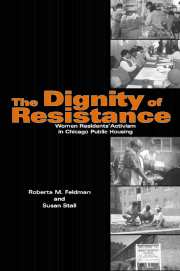Book contents
- Frontmatter
- Contents
- Foreword by Sheila Radford-Hill
- Preface and Acknowledgments
- PART I INTRODUCTION
- PART II WENTWORTH GARDENS' HISTORIC CONTEXT
- PART III EVERYDAY RESISTANCE IN THE EXPANDED PRIVATE SPHERE
- 4 The Community Household: The Foundation of Everyday Resistance
- 5 The Local Advisory Council (LAC): A Site of Women-Centered Organizing
- 6 Women-Centered Leadership: A Case Study
- 7 The Appropriation of Homeplace: Organizing for the Spatial Resources to Sustain Everyday Life
- PART IV TRANSGRESSIVE RESISTANCE IN THE PUBLIC SPHERE
- PART V CONCLUSIONS
- Epilogue
- Appendix A Timeline of Wentworth Gardens Resident Activists' Key Initiatives
- Appendix B A Demographic Profile of the Resident Community Activists Interviewed, 1992–1998
- References
- Index
7 - The Appropriation of Homeplace: Organizing for the Spatial Resources to Sustain Everyday Life
Published online by Cambridge University Press: 06 July 2010
- Frontmatter
- Contents
- Foreword by Sheila Radford-Hill
- Preface and Acknowledgments
- PART I INTRODUCTION
- PART II WENTWORTH GARDENS' HISTORIC CONTEXT
- PART III EVERYDAY RESISTANCE IN THE EXPANDED PRIVATE SPHERE
- 4 The Community Household: The Foundation of Everyday Resistance
- 5 The Local Advisory Council (LAC): A Site of Women-Centered Organizing
- 6 Women-Centered Leadership: A Case Study
- 7 The Appropriation of Homeplace: Organizing for the Spatial Resources to Sustain Everyday Life
- PART IV TRANSGRESSIVE RESISTANCE IN THE PUBLIC SPHERE
- PART V CONCLUSIONS
- Epilogue
- Appendix A Timeline of Wentworth Gardens Resident Activists' Key Initiatives
- Appendix B A Demographic Profile of the Resident Community Activists Interviewed, 1992–1998
- References
- Index
Summary
So I'm just saying this to tell you, there just comes a point and a time when there's a need for something, and a group of people gather and decide that they are going to do this for the benefit of their community – they can do it.
Hallie AmeyThe point and time were the 1960s, when, as we have described, public housing in the United States was beginning to witness the signs of governmental disinvestment. Daily life in Wentworth Gardens, as well as in other CHA housing, was beset with deteriorating physical facilities and services inadequate to meet the residents' needs. For Mrs. Hallie Amey, the point and time was when she and other women residents decided to challenge the closing of Wentworth Gardens' field house and the resultant dismantling of the youth recreation programs. It marked the Wentworth residents' first organized effort to improve the material conditions of their housing development.
APPROPRIATING THE FIELD HOUSE
When the development first opened, the on-site field house, or, as it was referred to in CHA documents, the “community building,” was intended for use as an auditorium, for social gatherings, and for classes for preschool children conducted by the city's Board of Education (CHA, 1947). Called the Wentworth Neighborhood Center, these programs were established through the cooperative efforts of Wentworth's Resident Council and Grace Community Center (CPHT, 1949), a private social service agency providing recreational activities for all ages.
- Type
- Chapter
- Information
- The Dignity of ResistanceWomen Residents' Activism in Chicago Public Housing, pp. 179 - 210Publisher: Cambridge University PressPrint publication year: 2004



